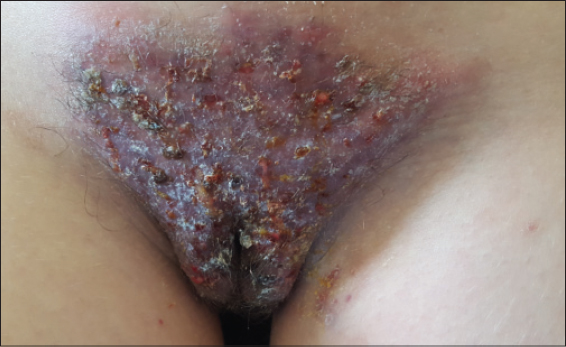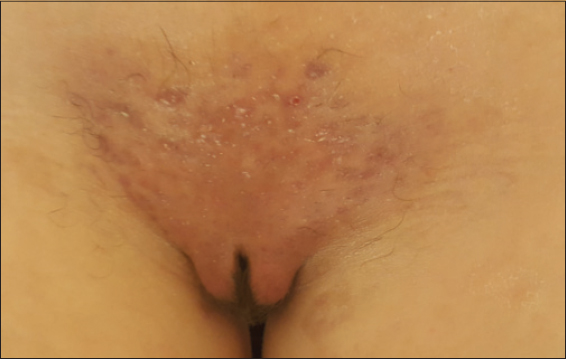|
Get Citation
|
|
|
Hassani CS, Galouj S, Mernissi FZ. Staphylococcal sycosis of pubis in a young girl: Exceptional location. Our Dermatol Online. 2018;9(2):215-216. |
|
|
Download citation file:
|
Staphylococcal sycosis of pubis in a young girl: Exceptional location
Cheymae Saadani Hassani, Salim Galouj, Fatima Zahra Mernissi
Departement of Dermatology, CHU Hassan II, Fes, Morocco
Corresponding author: Dr. Cheymae Saadani Hassani, E-mail: ch.saadani@gmail.com
Submission: 19.09.2017; Acceptance: 28.11.2017
DOI: 10.7241/ourd.20182.29
Staphylococcal sycosis is a rare variety of deep folliculitis caused by Staphylococcus aureus [1]. It is presented in the form of pustular inflammatory cupboards, maintained by shaving and poor hygiene. It mainly affects the hairy regions of the face [1]. We present a rare localization of staphylococcal sycosis in the pubis and vulva, in a teenage girl. A 15-year-old girl, consulted for painful, pubic and vulvar skin lesions, evolving for two months. The dermatological examination showed an erythematous-oedematous and infiltrated plaque, at the pubis and the vulva, with pustules and crusts, associated with partial depilation (Fig. 1). Dermoscopy was non-specific, showing follicular pustules and pubic anisotrichy (Fig. 2).
A pus collection with bacteriological study showed a staphylococcus aureus infection, while the mycological examination was negative.
The diagnosis of a pubic staphylococcal sycosis was retained.
The patient was put under fucidic acid 1g per day 10 days, with local treatment with an antiseptic and cream based on copper zinc. The evolution was favorable (Fig. 3). The pubis and the vulva constitute an exceptional location of the staphylococcal sycosis. Pediatric cases are rare [2]. It is seen mainly in man after puberty at the level of the beard.
It is often secondary to inoculation by the razor [3].
The diagnosis of sycosis of the pubis can sometimes be difficult to establish with other diagnoses such as a pubic celiac kerion, a pustular psoriasis, or even a cutaneous manifestation of a crohn.
The anti-staphylococcal treatment of the pubis appears effective and sufficient. The course under treatment is generally performed without sequelae.
REFERENCES
1. Manchanda Y, Khanna N, Pandhi RK, Das S, Sirka CS. Lupoidsycosis of pubic area. J Dermatol. 2003;30:248-9.
2. Hali F, Khadir K, Benchikhi H. Kérion du pubis chez une adolescente. Presse Med. 2013;42:1149–50.
3. Hay RJ, Adriaans BM. Bacterial infections. In:A Rook, D Wilkinson, J Ebling. Texbook of dermatology, 6th ed. Oxford, Blackwell Science, 1998:1120-1.
Notes
Source of Support: Nil
Conflict of Interest: None declared.



Comments are closed.